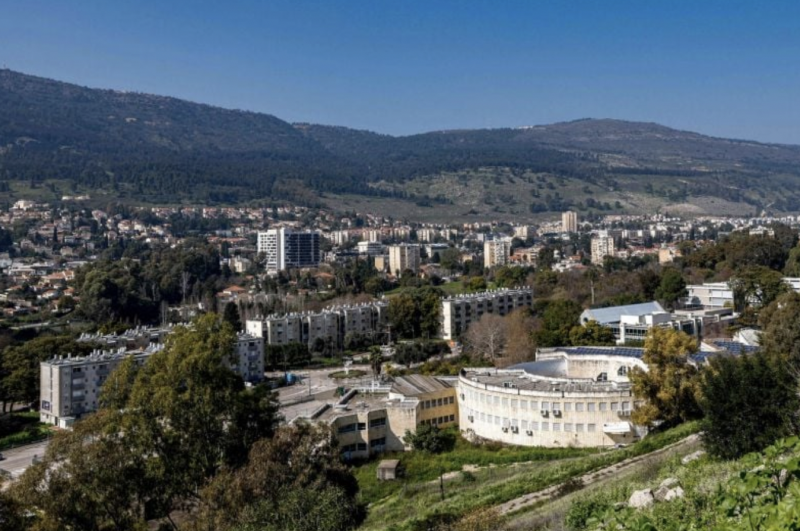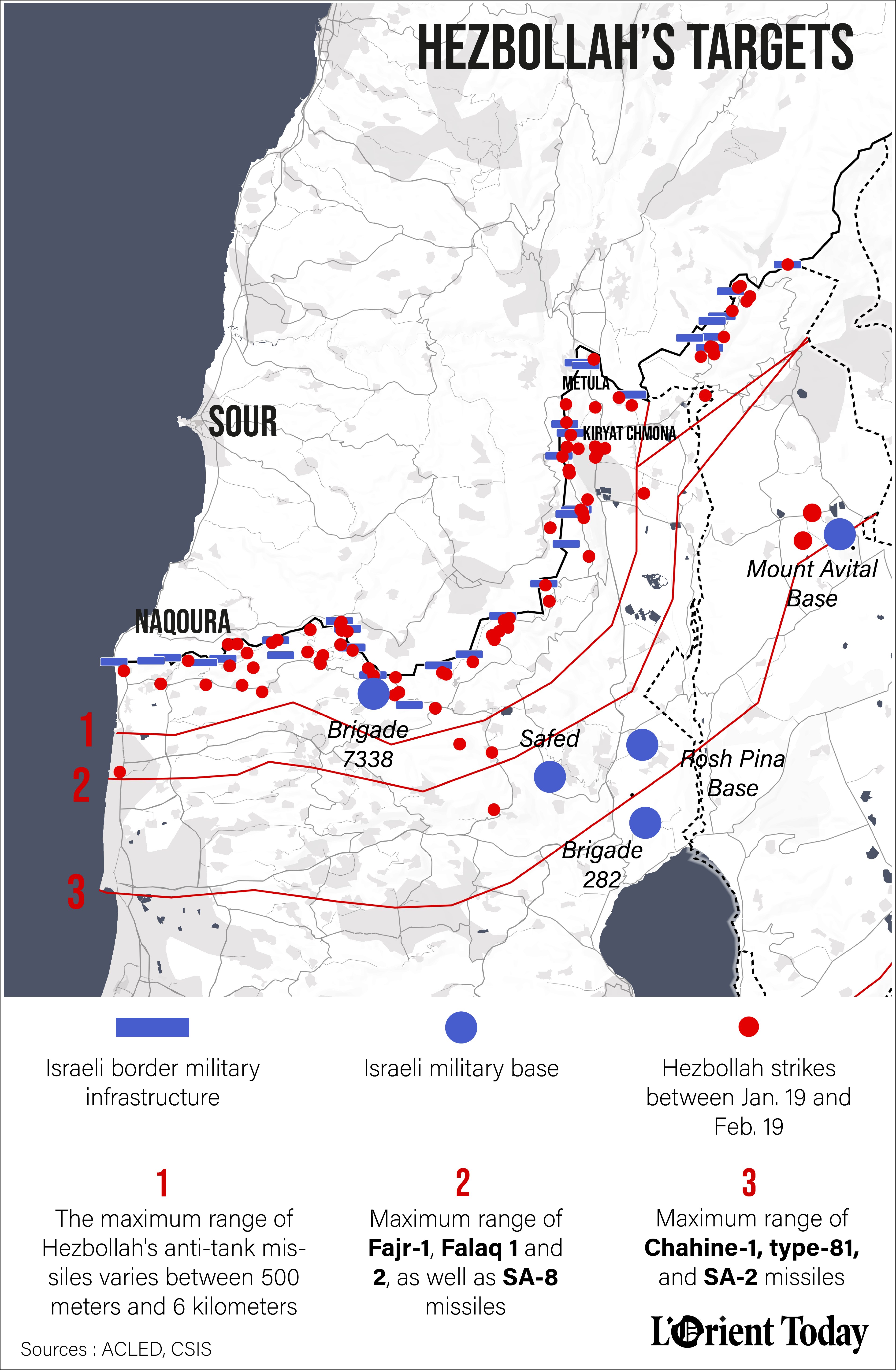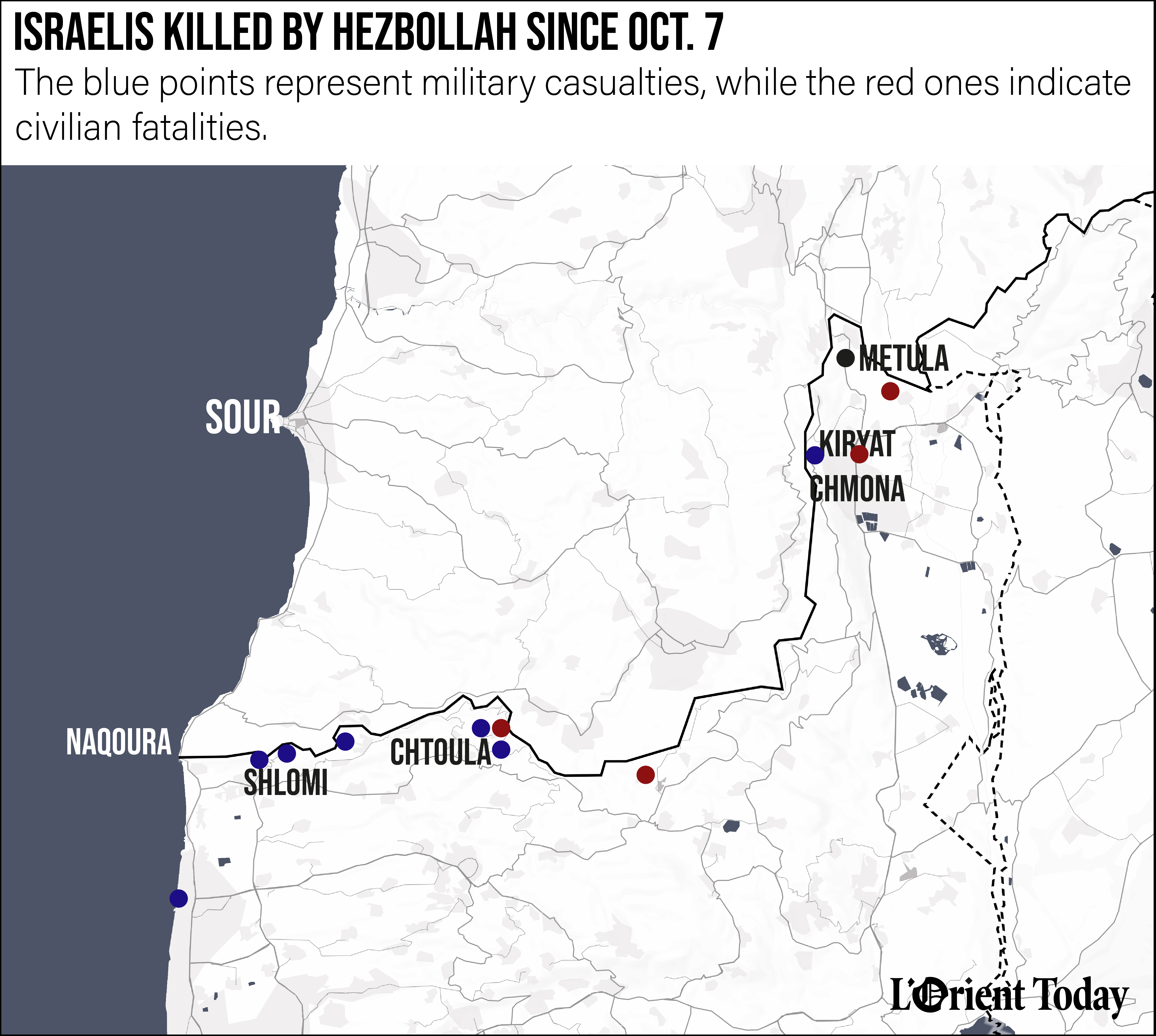
Kiryat Shmona, a town in northern Israel repeatedly targeted by Hezbollah, Feb. 11, 2024. (Credit: Jalaa Marey/AFP)
“In solidarity with the Palestinian people’s resistance in the Gaza Strip...” began most of Hezbollah’s press releases announcing its strikes against Israel, a practice that has persisted since the outbreak of hostilities in southern Lebanon on Oct. 8.
The press releases typically outlined the timing of the strike and briefly described the target, whether it’s a military infrastructure, soldiers, or simply an Israeli “position.”
Sometimes, details about the missiles used to strike the target were also provided.
Amidst this recurring pattern, a notable trend emerged: Strikes that reached deeper into Israeli territory, exemplified by the two strikes on Thursday, Feb. 22, which targeted military installations nearly 20 kilometers from the border.
More than four months since the onset of clashes along the southern border, let’s visually examine the strikes attributed to Hezbollah — their frequency, primary targets and the range of missiles within the group’s arsenal.
The range
Since Oct. 7, the overwhelming majority of “resistance” strikes on Israel have concentrated on targets within a range of less than six kilometers from the land border, utilizing anti-tank missiles readily available in large quantities.
Primary targets have consisted of Israeli defense structures along the border. However, many of these missiles have been thwarted in their attempts to reach their intended targets due to the Iron Dome, which employs guided missiles to intercept attacks mid-air.

For targets beyond six kilometers, Hezbollah possesses reworked Iranian and Chinese missile models, although their availability varies.
Additionally, the group possesses several missile models capable of targeting the entirety or a significant portion of Israeli territory, albeit in limited quantities.
Given this arsenal and the range of Hezbollah’s diverse missiles, numerous Israeli military bases would be directly imperiled should the group opt for deeper incursions into Israeli territory.
This is especially relevant for the quarters of the two Israeli artillery brigades tasked with guarding the border, namely brigades 7338 and 282, as well as the Mount Avital base, which accommodates an electronic intelligence unit.
According to Hezbollah, Thursday’s strikes were aimed at the Yoav and Kilaa barracks, both situated just a few kilometers from the Mount Avital base.
Quality vs quantity
The frequency of strikes has remained relatively consistent since the conflict’s onset: Not even the assassination of Hamas leader Saleh al-Arouri on Jan. 2 in the southern suburbs of Beirut resulted in a significant uptick in numbers.
However, in response to this assassination, Hezbollah claimed responsibility for targeting the Israeli air surveillance base of Meron with 62 rockets. This operation, considered one of the most significant of the war, reportedly caused considerable damage, according to Israel’s acknowledgment.
This type of operation appeared to echo the sentiments expressed by Nabil Kaouk, a member of Hezbollah’s Executive Council, who stated at the beginning of February that “the resistance has intensified its qualitative operations in response to the Israeli escalation.”
A qualitative operation, in military parlance, suggests an enhancement in the quality of an operation achieved through the implementation of improved tactics and equipment.
Another operation that appeared to demonstrate Hezbollah’s readiness to launch symbolic strikes occurred at the Safed base, headquarters of the army’s northern command, situated approximately 20 kilometers into Israeli territory. The operation took place on Jan. 9, following the elimination of Wissam Tawil, a commander of the al-Radwane force, Hezbollah’s elite unit.
Another strike on this base on Feb. 14, resulting in the death of a soldier, was not claimed by Hezbollah or any of the “resistance” groups operating along the border.
Human casualties
Since the onset of the conflict on Oct. 8, as per a tally conducted by AFP and L’Orient-Le Jour, 10 Israeli soldiers and six civilians have died in clashes along the border with Lebanon.
According to data available on the Israeli army website, eight of these military casualties were fatalities resulting from strikes originating from Lebanese territory, while two occurred during “clashes” after an attempted border infiltration on Oct.9.

Below is a chronological list of individuals killed in Hezbollah strikes, as announced by the Israeli army:
• Oct. 9: A soldier died in a strike in Adamit while responding to an infiltration alert.
• Oct. 12: A reservist was killed by an antitank missile at a military position in Arab al-Aramshe.
• Oct. 15: A lieutenant was killed, although the Israeli army did not disclose the location. On the same day, Hezbollah claimed responsibility for several strikes, including those on barracks in Shtula and Hanita.
• Dec. 16: A reservist was killed by an explosive drone near Margaliot.
• Dec. 22: A soldier was killed near Shtula.
• Dec. 26: A sergeant, wounded in the strike near Sthula on Dec. 22, succumbed to his injuries.
• Jan. 28: An officer and a soldier were killed in the occupied Shebaa farms.
The Israeli authorities have evacuated residents from all localities along the border to facilitate military operations and minimize civilian casualties.
Below is a timeline of civilians killed in Hezbollah strikes:
• Nov. 5: Two civilians were killed. The first casualty occurred in Yiftah. In response, the Israeli army targeted a car containing a woman and three young girls. Following this bombardment, Hezbollah launched Katyusha rockets at Kiryat Shmona, resulting in the death of one man.
• Nov. 13: A worker for Israel’s public electricity company was killed by a missile strike in Dovev.
• Dec. 22: A man in his forties was killed in Shtula after Hezbollah fired anti-tank missiles, as reported by Magen David Adom, the Israeli rescue service.
• Jan. 14, 2024: Israeli emergency services reported the deaths of two civilians, a man and his mother, who were killed in their home in Kfar Yuval.
Hezbollah claimed that its strikes resulted in 2,000 Israeli casualties, “including both fatalities and injuries.”
In Lebanon, where over 80,000 residents of the south have been displaced by the conflict, Israeli strikes have resulted in the deaths of 264 individuals, including 40 civilians, three journalists, one soldier and dozens of fighters from Hezbollah and other factions.
This article was originally published in L'Orient-Le Jour. Translated by Sahar Ghoussoub.